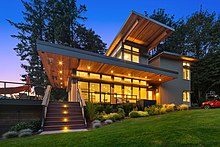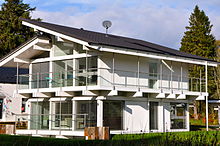
Lustron houses are prefabricated enameled steel houses developed in the post-World War II era United States in response to the shortage of homes for returning G.I.s by Chicago industrialist and inventor Carl Strandlund. Considered low-maintenance and extremely durable, they were expected to attract modern families who might not have the time or interest in repairing and painting conventional wood and plaster houses. Lustron production ceased in 1950 due to the company's inability to pay back the startup loans it had received from the Reconstruction Finance Corporation. Over 2,000 homes were constructed during the Lustron's brief production period, and many remain in use today. Several have been added to the National Register of Historic Places.
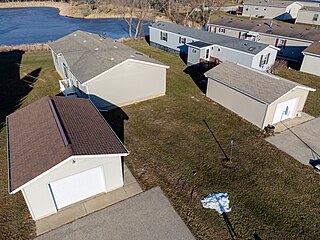
A mobile home is a prefabricated structure, built in a factory on a permanently attached chassis before being transported to site. Used as permanent homes, or for holiday or temporary accommodation, they are often left permanently or semi-permanently in one place, but can be moved, and may be required to move from time to time for legal reasons.

A modular building is a prefabricated building that consists of repeated sections called modules. Modularity involves constructing sections away from the building site, then delivering them to the intended site. Installation of the prefabricated sections is completed on site. Prefabricated sections are sometimes placed using a crane. The modules can be placed side-by-side, end-to-end, or stacked, allowing for a variety of configurations and styles. After placement, the modules are joined together using inter-module connections, also known as inter-connections. The inter-connections tie the individual modules together to form the overall building structure.
Prefabrication is the practice of assembling components of a structure in a factory or other manufacturing site, and transporting complete assemblies or sub-assemblies to the construction site where the structure is to be located. Some researchers refer it to “various materials joined together to form a component of the final installation procedure“.

Dwell is a design and technology brand. It was launched with a magazine in October 2000 by CEO Lara Hedberg Deam with architecture and design critic Karrie Jacobs as its editor-in-chief. In August 2002, Jacobs left the magazine and was replaced by senior editor Allison Arieff. After Arieff, Sam Grawe held the position from 2006 to 2011, followed by Amanda Dameron from 2011 to 2017. William Hanley became the editor-in-chief in 2019.
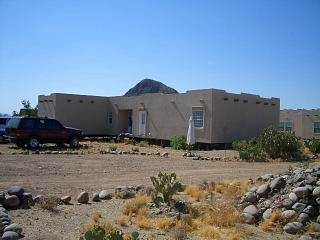
Manufactured housing is a type of prefabricated housing that is largely assembled in factories and then transported to sites of use. The definition of the term in the United States is regulated by federal law : "Manufactured homes are built as dwelling units of at least 320 square feet (30 m2) in size with a permanent chassis to assure the initial and continued transportability of the home." The requirement to have a wheeled chassis permanently attached differentiates "manufactured housing" from other types of prefabricated homes, such as modular homes.

Home construction or residential construction is the process of constructing a house, apartment building, or similar residential building generally referred to as a 'home' when giving consideration to the people who might now or someday reside there. Beginning with simple pre-historic shelters, home construction techniques have evolved to produce the vast multitude of living accommodations available today. Different levels of wealth and power have warranted various sizes, luxuries, and even defenses in a "home". Environmental considerations and cultural influences have created an immensely diverse collection of architectural styles, creating a wide array of possible structures for homes.

A portable, demountable or transportable building is a building designed and built to be movable rather than permanently located.

A prefabricated building, informally a prefab, is a building that is manufactured and constructed using prefabrication. It consists of factory-made components or units that are transported and assembled on-site to form the complete building. Various materials were combined to create a part of the installation process.
Offsite construction refers to the planning, design, manufacture and assembly of building elements at a location other than their final installed location to support the rapid speed of, and efficient construction of a permanent structure. Such building elements may be prefabricated offsite in a different location and transported to the site or prefabricated on the construction site and then transported to their final location. Offsite construction is characterized by an integrated planning and supply chain optimization strategy. Offsite manufacturing (OSM), offsite production (OSP) and offsite fabrication (OSF) are terms used when referring primarily to the factory work proper.

Cemesto is a sturdy, lightweight, waterproof and fire-resistant composite building material made from a core of sugarcane fiber insulating board, called Celotex, surfaced on both sides with asbestos cement. It was originally developed by the Celotex Corporation and first introduced to the market in 1937.

Homes England is the non-departmental public body that funds new affordable housing in England. It was founded on 1 January 2018 to replace the Homes and Communities Agency (HCA). HCA in turn was established by the Housing and Regeneration Act 2008 as one of the successor bodies to the Housing Corporation, and became operational on 1 December 2008.

Modular construction is a construction technique which involves the prefabrication of 2D panels or 3D volumetric structures in off-site factories and transportation to construction sites for assembly. This process has the potential to be superior to traditional building in terms of both time and costs, with claimed time savings of between 20 and 50 percent faster than traditional building techniques.
Joseph Tanney is an American architect based in New York City. He is known for his work in prefabricated housing. He gained international attention with the Dwell Home, the winner of a 2003 international competition, which is considered a modern prefab icon.
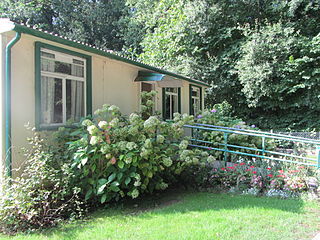
Prefabs were a major part of the delivery plan to address the United Kingdom's post–World War II housing shortage. They were envisaged by war-time prime minister Winston Churchill in March 1944, and legally outlined in the Housing Act 1944.
Archimede construction systems are construction techniques achieving rhombic dodecahedral shapes, a space-filling geometry. In America, most of these systems generate building envelopes made up of as little as two panel shapes and sizes, this feature allowing for maximum industrialization. These panels are generally pressure injected with a rigid structural insulating foam like polyurethane. In Europe and Asia, post and beam structure often create a dodecahedral shape that is later filled with different cladding materials. Although the basic geometry sometimes contains an entire house, most applications of the system are an agglomeration of cells each forming a rhombic dodecahedral living space that can be a room or a larger living area when combined with adjacent dodecahedral modules.

A council house or council flat is a form of British public housing built by local authorities. A council estate is a building complex containing a number of council houses and other amenities like schools and shops. Construction took place mainly from 1919 after the Housing Act 1919 to the 1980s, with much less council housing built since then. There were local design variations, but they all adhered to local authority building standards. The Housing Acts of 1985 and 1988 facilitated the transfer of council housing to not-for-profit housing associations with access to private finance, and these new housing associations became the providers of most new public-sector housing. The characterisation of council houses as 'problem places' was key for leading this movement of transferring public housing stock to the private arena. By 2003, 36.5% of the social rented housing stock was held by housing associations.
Resolution: 4 Architecture (RES4) is a ten-person architecture firm based in New York City, founded by architects Joseph Tanney and Robert Luntz in 1990. The firm is most recognized for their work on prefabricated housing and mass customization of the single-family house.
Ilke Homes was a UK housebuilder specialising in modular homes for both social housing and for open market sale and private rental. Established in 2017, it went into administration in June 2023, owing £320 million and making over 1,100 workers redundant.
Modern methods of construction (MMC) is a term used in the UK construction industry to refer to "smart construction" processes designed to improve upon traditional design and construction approaches by focusing on component and process standardisation, design for manufacture and assembly (DfMA), prefabrication, preassembly, off-site manufacture and onsite innovations such as additive manufacture. While such modern approaches may be applied to infrastructure works and to commercial or industrial buildings, MMC has become particularly associated with construction of residential housing.



